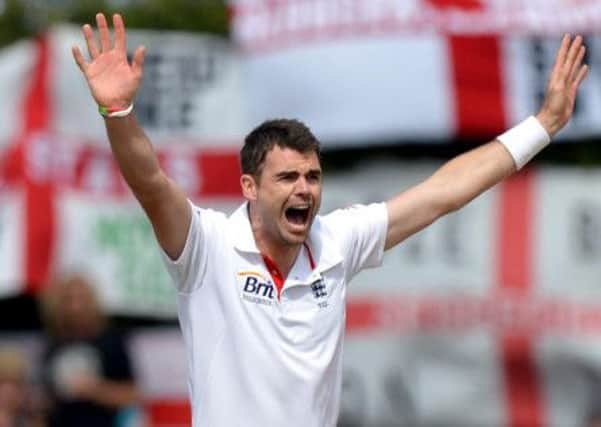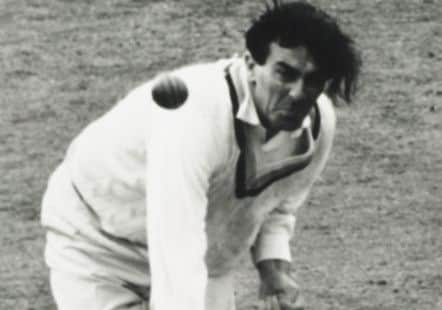Roses duo spark great pace debate ahead of Leeds Test


THE stage is set for one of those mischievous touches that one suspects fate might have pre-ordained.
At some point during the Headingley Test – no doubt while bowling from the Kirkstall Lane end and with the cheers of the Trueman Enclosure ringing in his ears – James Anderson will almost certainly capture his 308th Test wicket.
Advertisement
Hide AdAdvertisement
Hide AdIn so doing, he would pass the late, great Fred Trueman as England’s third-highest wicket-taker in Test cricket on the ground Trueman called home for 20 years.


It is enough to make any man splutter – through prodigious plumes of pipe smoke – “I don’t know what’s going off out there”.
Anderson’s achievement in becoming only the fourth Englishman to take 300 Test wickets at Lord’s last week was one deservedly roared to the rafters.
And, for all his reputation as a man unafraid to extol his own virtues, Trueman would have been among the first to congratulate the outstanding Lancastrian.
Advertisement
Hide AdAdvertisement
Hide AdOf course, he would not have missed the opportunity to point out that he himself got to the milestone in 65 Tests, whereas Anderson needed 81, for Trueman knew more statistics than Opta – and his own figures especially.
But he would have recognised Anderson’s efforts in reaching the landmark, one which Trueman was famously the first to attain when he dismissed Australia’s Neil Hawke at The Oval in 1964.
Yet do statistics provide the final word when it comes to assessing the respective merits of Trueman and Anderson, and is it possible to compare them in any case?
Popular wisdom dictates that one can only effectively compare players from the same era, while it is a fact that Trueman and Anderson are characterised more by their differences than their similarities.
Advertisement
Hide AdAdvertisement
Hide AdTrueman was quicker, more side-on and relied principally on pace and swing, while Anderson seams it more and possesses a handy line in reverse-swing, too.
There are physical differences also; Trueman was built like the proverbial brick outhouse with shoulders wider than a suspension bridge and legs that might have been borrowed from a billiard table, while Anderson is more lithe and athletic than what might be termed physically imposing.
Statistics, however, are nothing if not suggestive and come down firmly in the Yorkshireman’s favour.
In 67 Tests, the last of them against New Zealand at Lord’s in 1965, Trueman took 307 wickets at 21.57; Anderson’s 305 have arrived at 30.14.
Advertisement
Hide AdAdvertisement
Hide AdOf the 26 bowlers to have taken 300 Test wickets, only Malcolm Marshall (376 at 20.94) and Curtly Ambrose (405 at 20.99) had a better average than Trueman, while only four (Dale Steyn 41, Waqar Younis 43, Marshall 46 and Allan Donald 47) can beat his strike-rate of a wicket every 49 balls.
Furthermore, Trueman’s total of 2,304 first-class wickets at 18.29 is the most by a genuinely fast bowler and will remain so for all time now that one-day cricket and central contracts are here to stay.
Those who would advance the claims of Anderson, such as the former Essex and England all-rounder Derek Pringle, have pointed out that Trueman bowled on uncovered pitches and against emerging Test nations unaccustomed to facing players of his pace.
The 1952 Indians were a prime example, blown away by the 21-year-old Trueman and famously reduced to 0-4 on his Test debut at Headingley.
Advertisement
Hide AdAdvertisement
Hide AdWith pitches now covered, Pringle argues that Anderson has had to rely more on clever variation.
David Saker, the England bowling coach, actually thinks that Anderson’s variations make him the most skilful bowler on the planet – more so, even, than South Africa’s Steyn.
Mark Nicholas, the former Hampshire captain, is another firm advocate of Anderson’s skills.
Writing after the Lord’s Test, Nicholas opined that none of the first three Englishmen to the 300-mark (Trueman, Bob Willis and Ian Botham) “could have bowled any more beautifully” than Anderson at Lord’s.
Advertisement
Hide AdAdvertisement
Hide Ad“Nor,” added Nicholas, “could Malcolm Marshall or Dennis Lillee or anyone else you care to name”.
Nicholas went on: “At his best, Anderson glides to the wicket and then, with feline agility, gathers himself to deliver and strike.
“Like Marshall, the wrist is the key along with commitment to the idea.”
Trueman’s supporters would point out that he, too, was a complete package, that he did not play against the likes of Bangladesh and Zimbabwe, as Anderson has, and that he was not averse to using his mind either, such as when he famously reduced his pace against Australia at Headingley in 1961 to take 5-0 in 27 balls with off-cutters.
Advertisement
Hide AdAdvertisement
Hide AdBob Platt, who opened the bowling with him for many years at Yorkshire, is adamant that Trueman was the greatest fast bowler of all – period.
“Fred was the greatest of the great in my opinion; he played for 20-odd years and never broke down,” said Platt.
“You’ve only got to look at the sort of people he was bowling against, the likes of the West Indian batsmen Clyde Walcott, Everton Weekes, Frank Worrell, Rohan Kanhai, Garry Sobers.
“Anderson is a fine, fine bowler and I admire him very much for sticking to his guns and going back to what he was when he first started before England tried to alter him.
Advertisement
Hide AdAdvertisement
Hide Ad“But Fred was a great, great bowler, it’s as simple as that.”
Platt believes they are too dissimilar to be properly compared. “Fred and James Anderson are different types of bowlers,” he added.
“Fred was three-quarters of a yard quicker for a start, and he bowled late out-swingers at 90mph and relied on his pace and devastating swing.
“I was told that Fred was clocked at 93mph in Australia, and Anderson doesn’t get up to that sort of speed.
Advertisement
Hide AdAdvertisement
Hide Ad“He’s more of an 86, 87 man, but I wouldn’t decry him for one moment because I think he’s a wonderful bowler and he’s done tremendously well in the last few years.”
Trueman and Anderson, Anderson and Trueman.
As Bob Platt says, two wonderful bowlers with perhaps not much in common beyond that fact.
Let us not argue their respective merits but celebrate instead their respective talents.
Should Anderson take his 308th Test wicket at Leeds, let us pause for a moment – amid the outpouring of acclaim – to remember the very great bowler who set the benchmark all those years ago.